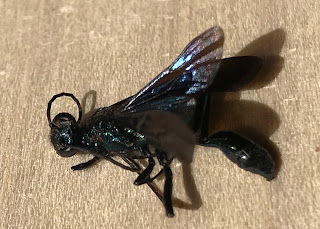The last week we have been finding these iridescent dark blue wasps hovering around our windows trying to find their way out. They also enter through tiny gaps in the soffit above the front door. Fortunately they are easy to catch and transport outside where they probably start the same trip again, thinking "Didn't I just do this a while ago?"
 These are Chalybion sp., a genus of blue mud dauber wasps in the thread-waisted wasp family, Sphecidae. Mud dauber is a general term and many species have never daubed mud a day in their life. Chalybions tend to nest in natural and
artificial cavities such as holes in wood, walls, plant stems, etc. Some even reuse old nests of other wasps, removing the larvae and residual materials. They even bring in water and remodel the nest before laying in provisions and an egg. A silken cocoon will soon be formed.
These are Chalybion sp., a genus of blue mud dauber wasps in the thread-waisted wasp family, Sphecidae. Mud dauber is a general term and many species have never daubed mud a day in their life. Chalybions tend to nest in natural and
artificial cavities such as holes in wood, walls, plant stems, etc. Some even reuse old nests of other wasps, removing the larvae and residual materials. They even bring in water and remodel the nest before laying in provisions and an egg. A silken cocoon will soon be formed. |
| "Just chillin out" - refrigerator cooled for a still portrait |
This is a blue mud wasp, Chalybion californicum (Cc), one of the most common mud dauber species in Missouri according to MDC. I just had an inquiry from MDC about a "swarm" of wasps including this one to the right that looks just like ours. Cc and other related Chalybions are solitary wasps, meaning that they form an individual nest. They may have neighboring nests where there is good habitat giving the perception of a community. The forest service website explains how a "swarm" might appear.
"Chalybion californicum is a solitary wasp, and the females build and supply the nests individually. However, clusters of both sexes have been reported in low-light situations like at night or on a cloudy day in the shadow of a building or a rock. There can be several generations of wasps in a year."Forest Service
Only female wasps have stingers which are actually modified ovipositors. Most wasps are reluctant to sting, reserving it for defense when threatened. Chalybion sp. are rarely aggressive and actually a beneficial species if they aren't hanging around inside the house.
 |
| Aa on golden Alexander |
The adults feed on nectar and are pollinators for may common native plants such as Queen Anne's lace, Daucus carota, and golden Alexander, Zizia aurea. Meanwhile they catch high protein insects which they paralyze with their stinger and give them to their developing young. Frequently they catch black widow spiders! What is not to love about these cuties?

